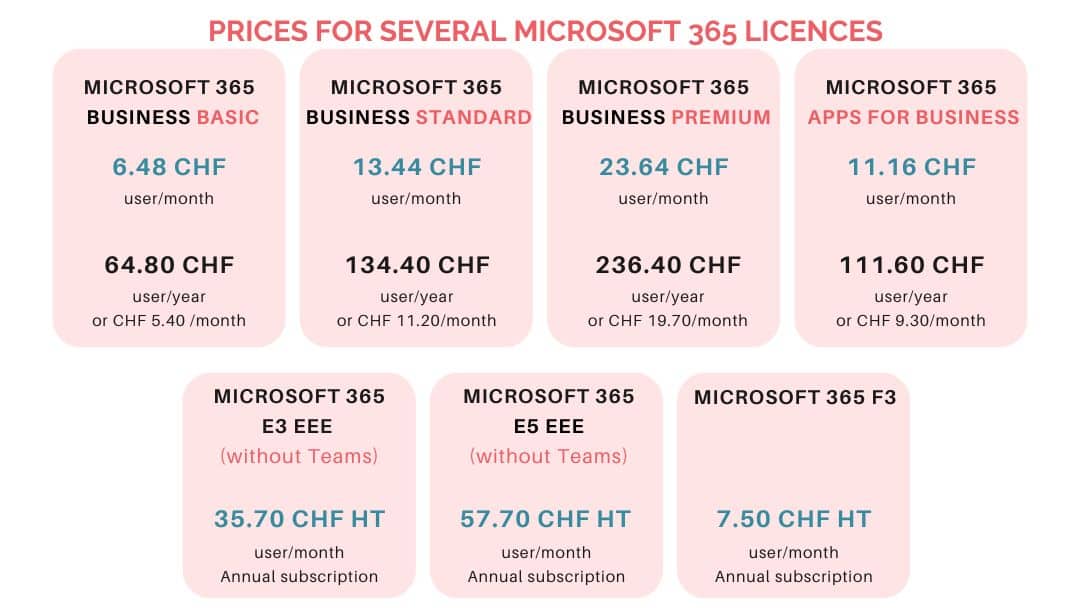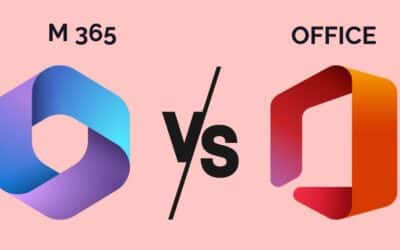Choosing between keeping permanent licenses (Office 2024 for example) or switching to a subscription (Microsoft 365) directly impacts your IT budget and productivity. Microsoft 365 is more than just Word, Excel and PowerPoint: it’s a complete cloud ecosystem, with continuous updates, integrated collaborative services, advanced security and, more recently, artificial intelligence features.
In this article, we analyze the strengths and weaknesses of Microsoft 365 to help you determine whether it really meets your business needs. And while we use the term “Office 365”, we’re really talking about subscription-based offerings.
Office 365 vs Microsoft 365
Just a few years ago, the name Office 365” referred to all Microsoft productivity subscriptions, including office applications, collaborative tools, cloud services and certain security features.
But since 2020, most of these offerings have been renamed as “Microsoft 365”. That’s what we’ll be looking at throughout this article.
Today, “Office 365” refers to just a few offerings for large enterprises, sold without Teams by default, but which can include it as an option: Office 365 E1, Office 365 E3 and Office 365 E5. You’ll find comparisons here and here.
💡Good to know: we’ve written a full article on the differences between Microsoft 365 and Office.
What services does Office 365 offer?
Microsoft 365 is a subscription that combines 4 services:
- The well-known office suite with Word, Excel, PowerPoint, Outlook, OneNote, Publisher and Access applications, in mobile, desktop or web versions, depending on the license chosen;
- A set of cloud-based online services, such as Teams, Viva Engage, Exchange, OneDrive and SharePoint Online;
- Copilot artificial intelligence functionality, integrated into office applications and available as an add-on ;
- Security and compliance features such as Microsoft Defender, Entra ID, Intune and Purview (in certain packages only, such as Business Premium or Microsoft 365 E5).
The precise list of services and applications varies according to the license chosen.
What are the advantages of Office 365?
Accessible from any device
One of the great strengths of Microsoft 365 lies in its ability to run smoothly on a wide variety of devices (although some advanced features will be limited on mobile, for example) :
- Windows PC,
- Mac,
- tablet,
- smartphone (iOS or Android).
You can access your office applications through optimized versions for each platform. In fact, Microsoft 365 offers :
- The mobile version,
- The web version,
- The desktop version.
Finally, each user can install Office applications on up to 5 devices (computers, tablets and smartphones) with a single license, avoiding the need to purchase multiple licenses for each device.
Please note, however, that some licenses offer neither the desktop version of office applications, nor the possibility of installing applications on 5 different devices with a single license. This is the case for :
- Microsoft 365 Business Basic
- Microsoft 365 E5 Security
- Microsoft 365 E5 Compliance
- Microsoft 365 F1.
Continuous updates and latest features
Unlike perpetual versions like Office 2024, Microsoft 365 offers a constant stream of enhancements. This aspect, often perceived as technical, is actually an advantage for businesses.
On the one hand, applications are always up to date, without the need to buy a new license every 2 or 3 years. Updates are integrated into the subscription and deployed automatically, without service interruption.
On the other hand, Microsoft regularly enhances its tools with new functions, ergonomic improvements, cloud integrations or artificial intelligence capabilities. For example, AI features such as Microsoft 365 Copilot are only available to users with the latest versions.
What’s more, for companies equipped with an IT team or service provider, Microsoft 365 offers controllable update channels. It is possible to choose a deployment rhythm (monthly or semi-annually), test new features in advance, and ensure compatibility with the internal environment.
Finally, updates also include the latest security patches. This reduces exposure to vulnerabilities and ensures ongoing compliance, without relying on manual installation of patches or fixes.
Real-time collaboration and teamwork
Everything is designed to simplify day-to-day exchanges.
Firstly, with real-time co-editing. Thanks to the Word, Excel and PowerPoint applications (in web or desktop versions), several users can edit the same document simultaneously. This native feature eliminates the need to email back and forth, and avoids version conflicts.
Then there’s simplified document sharing, with files centralized in OneDrive Enterprise for individual use, or in SharePoint Online for team spaces. You can :
- share a document with colleagues or external partners,
- define access rights (read-only, modification, etc.),
- set a link expiration date or block a file download.
What’s more, Microsoft Teams integrates with the entire Microsoft 365 ecosystem to centralize exchanges:
- instant conversations and online meetings,
- direct collaboration on files from a team or channel,
- integrated access to SharePoint, OneNote, Planner, etc.
Finally, users can comment on documents, mention a colleague with @name, follow suggestions and return to an earlier version thanks to the automatic history.
💡 Good to know : what are the prerequisites for optimal collaboration?
- Real-time co-editing: documents must be saved in OneDrive Enterprise or SharePoint Online.
- Some advanced options (comments, track changes) may be limited on mobile or lite web versions.
- External sharing: the Microsoft 365 administrator must have enabled external sharing in the company settings.
Flexibility and scalability
Microsoft 365 is often presented as a flexible, scalable solution.
Flexibility refers to Microsoft 365’s ability to adapt to different uses, profiles and work contexts. It is demonstrated by :
- Access to services from any device;
- Choice of different licenses (Business Basic, Premium, E3, etc.);
- The ability to work in the office, remotely or on the move, with uninterrupted access and functionality;
- Simple license management: add, delete or modify licenses as teams evolve;
- Activate add-ons such as Copilot, Teams Phone or Microsoft Defender.
Scalability refers to Microsoft 365’s ability to keep pace with changes in your business, without overhauling your existing environment. It translates into :
- Add users without technical limits in Enterprise offers (E3, E5);
- Progressive upgrading: a company can start with Business Premium and upgrade to E3 or E5 when it exceeds 300 users or adds compliance requirements;
- The ability to evolve towards a hybrid or multisite model, without changing the technological base.
Data security
Microsoft 365 (formerly Office 365) is very secure overall. Microsoft invests billions of dollars a year in cybersecurity, and offers many advanced security and compliance features, even in its basic offerings.
Here’s what Microsoft is doing to secure data :
- Data encryption at rest and in transit (TLS, BitLocker, etc.).
- Multi-factor authentication (MFA).
- Identity management with Azure Active Directory.
- Threat detection via Microsoft Defender for Office 365.
- Logging and auditing for traceability.
- Compliance with standards: RGPD, ISO 27001, HIPAA, etc.
The disadvantages of Office 365
While Office 365 offers many advantages, it also has some drawbacks that can affect its suitability for certain business sectors.
High and sometimes inappropriate costs
Firstly, the Microsoft 365 business model marks a departure from traditional perpetual licenses. In the long term, it generally represents a higher cost, especially for users with stable needs. Users no longer really own the suite: they rent access to it in a potentially permanent subscription model.
Secondly, Microsoft offers a highly modular system, appreciated for its flexibility, but often costly. For businesses, the price tag quickly climbs as more users are added, or as specific functionalities (enhanced security, analysis tools, compliance, etc.) are added. It’s not uncommon to have to combine several plans (e.g., a mix of E3 and pay-as-you-go add-ons) to meet all your needs.
Finally, companies sometimes pay for features they don’t use. Microsoft favors a grouped approach via “all-in-one” subscriptions, but not all customers have the same uses or priorities.
The solution: take the time to really compare licenses. There are many plans to choose from, and it’s not an easy task. That’s where SmartYou can help.

Dependence on Internet connection
Microsoft 365 relies heavily on the cloud, and without a connection, a number of features are no longer accessible:
- Office Web applications (Word Online, Excel Online, etc.)
- Real-time collaboration on documents
- Access to OneDrive or SharePoint via the cloud (without local synchronization)
- Microsoft Teams
- Outlook Web access and e-mail synchronization (Exchange Online)
- Automatic Office suite updates
- Access to administration tools
- Using Power BI, Power Automate or other advanced cloud services
- Artificial intelligence and connected search functionalities (Copilot, contextual search, intelligent suggestions).
💡 What about desktop versions of office tools? We’ve seen that they’re included in some licenses, but not all. When these applications are installed locally, it’s perfectly possible to work offline, provided that documents are saved on the computer or synchronized via OneDrive or SharePoint.
However, offline mode does have its limitations. For example, Outlook Web App does not offer reliable offline operation: only the Outlook desktop client provides true access to recent messages, calendar and drafts, thanks to cached synchronization. Some functions, such as attachments, advanced search and e-mail sending, remain unavailable without a connection.
OneDrive & SharePoint, powerful tools but not without flaws
Microsoft has developed OneDrive and SharePoint from older technical foundations, often gradually adapted to meet new uses such as real-time collaboration and cloud synchronization. Both services are powerful and feature-rich, but can become complex to master.
Several types of problems are frequently reported:
- Unstable synchronization (especially with OneDrive): files blocked or not synchronized, version conflicts (when several people modify the same file in parallel or offline), file explorer update delays, or even status icons that can be misleading.
- Variable performance depending on the size of SharePoint libraries: beyond 5,000 items displayed in a library, technical limitations may affect performance or prevent certain operations (filters, sorting, displays). The use of complex metadata or non-optimized third-party tools can also affect service fluidity.
- Complexity in managing access rights: inherited permissions can be broken unintentionally, and sharing parameters are sometimes misunderstood, increasing the risk of data leakage or unintentional blocking.
- Sometimes confusing integration between OneDrive, SharePoint and Teams: documents shared in a Teams channel are actually stored in a SharePoint library, which is not always obvious to users. What’s more, the mix between personal space (OneDrive) and team space (SharePoint) can be confusing when it comes to file management.

Book a free Modern Workplace diagnostic
Are your IT tools really adapted to your needs? Take advantage of a free 30-minute diagnostic to assess your current infrastructure and identify opportunities for improvement.
Alternatives to Office 365
We’ve detailed them in a dedicated article, Ranking of the 7 best alternatives to Microsoft 365. In short, if you want a complete tool that offers an office suite, professional messaging, online storage and collaborative tools, there are currently only two options: Google Workplace and Zoho Workplace.
We have devoted a detailed article to this subject, Microsoft vs Google to the comparison between the two giants. These are two very similar solutions. Google Workspace is a little more affordable.
Prices for Google Workspace :
- Business Starter: CHF 7 per month per user
- Business Standard: CHF 14 per month per user
- Business Plus: CHF 22 per month per user
- Company: rates on request
As for Zoho Workplace, it is particularly suited to small and medium-sized businesses looking for a cost-effective alternative, without sacrificing essential collaborative functionality. On the other hand, for large structures or environments requiring advanced office automation or massive cloud storage, it may show its limitations.
Zoho Workplace indicative prices (annual subscription) :
- Workplace Standard: approx. CHF 2.70 per user per month, with 30 GB storage.
- Workplace Professional: approx. CHF 4.50/user/month, with 100 GB storage and advanced functions such as extended videoconferencing, user rights management and e-mail auditing.
| Microsoft 365 | Google Workspace | Zoho Workplace | |
| Office suite | Word, Excel, PowerPoint, OneNote | Docs, Sheets, Slides, Keep | Writer, Sheet, Show |
| Professional messaging | Outlook (Exchange). | Gmail | Zoho Mail |
| Online storage | OneDrive (1 TB per user for Business plans, unlimited storage for some Enterprise plans) | Google Drive (Business Starter 30 GB; Standard 2 TB; Business Plus and Enterprise 5 TB per user, unlimited storage possible depending on configuration) | WorkDrive (30 to 100 GB depending on plan, extensions possible) |
| Collaborative tools | Teams SharePoint, Viva Egage | Meet, Chat | Zoho Cliq (chat), Zoho Meeting, collaborative editing on Writer/Sheet/Show |
| Safety tools | Defender, Entra ID | Identity Platform, Advanced Protection Program | Email encryption, two-factor authentication (2FA), Zoho privacy policy |
| Compliance tools | ISO 27001, RGPD, SOC 1/2/3, etc. | ISO 27001, RGPD, SOC 1/2/3, etc. | RGPD, ISO 27001, SOC 2 Type II (certifications available according to services) |
| AI functions | Copilot | Gemini | Zia |
| Mobility and multi-device accessibility | PC, Mac, smartphones and tablets (iOS and Android), dedicated mobile applications. | PC, Mac, smartphones and tablets (iOS and Android), dedicated mobile applications. | PC, Mac, iOS, Android – dedicated Zoho mobile applications |
| Integration with third-party tools | yes | yes | yes |
| Centralized administration and management | Microsoft 365 Administration Center and Microsoft Entra ID | Google Admin Console | Zoho Workplace administration console |
| Data backup and restoration | Backup via OneDrive and SharePoint, with advanced restore functions | Backup and restore via Google Vault and Google Drive | Restore e-mails, files and manage logs according to plan; e-mail archive possible |
| Flexible subscription models for businesses | yes | yes | yes |
SmartYou helps you choose your complete solution
Our aim is not to sell you a license, but to guide you towards a solution that is truly adapted to your needs.
The first step in our collaboration is therefore a detailed analysis of your company’s IT structure and governance , including an assessment of your actual usage, as well as the evolution of your business.
In conclusion, to explore in more detail how Office 365 can fit into your IT strategy, our Modern Workplace services will be happy to answer any questions you may have.




